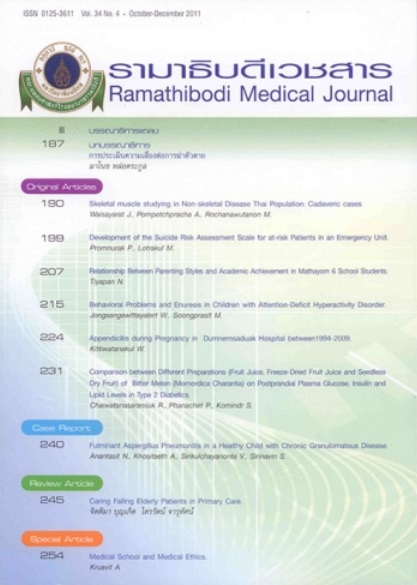Behavioral Problems and Enuresis in Children with Attention-Deficit Hyperactivity Disorder
Keywords:
Nocturnal enuresis, ADHD, PrevalenceAbstract
Objective: To assess the prevalence of enuresis in children with attention-deficit hyperactivity disorder (ADHD) and to compare behavioral problems in ADHD children with and without enuresis.
Method: The sample group was 136 ADHD children aged between 6-11 years who were on treatment at Child and Adolescent Psychiatric Clinic of Ramathibodi Hospital. Data collection from children’s parents was done by using two types of questionnaire; Enuresis-Screening Questionnaire and The Strengths and Difficulties Questionnaire (SDQ).
Results: From a sample group of 136 ADHD children, approximately 20.59% of the group had enuresis after the age of 5 years. Only 11.03% of sample group had nocturnal enuresis that followed the DSM-IV diagnostic criteria. In the characteristic comparison between ADHD children with and without Enuresis, there were indifferences in gender, parents’ educational level, income as well as no correlation with history of enuresis in parents. SDQ showed that conduct problem scores in ADHD children with enuresis were significantly higher than the scores of the group without enuresis. However, there was no difference of strength scores between the two groups.
Conclusion: ADHD children with enuresis had a greater correlation with conduct problem than ADHD children with enuresis. It’s highly essential that child and adolescent psychiatrists promptly detect problems and give a proper treatment since the early stage in order to mitigate effects on patients and families.
References
Biederman J, Faraone SV. Attention-deficit hyperactivity disorder. Lancet. 2005;366(9481):237-48. doi:10.1016/S0140-6736(05)66915-2.
Benjasuwantep B, Ruangdaraganon N, Visudhiphan P. Prevalence and clinical characteristics of attention deficit hyperactivity disorder among primary school students in Bangkok. J Med Assoc Thai. 2002;85 Suppl 4:S1232-40.
Shreeram S, He JP, Kalaydjian A, Brothers S, Merikangas KR. Prevalence of enuresis and its association with attention-deficit/hyperactivity disorder among U.S. children: results from a nationally representative study. J Am Acad Child Adolesc Psychiatry. 2009 ;48(1):35-41. doi:10.1097/CHI.0b013e318190045c.
Ghanizadeh A, Mohammadi MR, Moini R. Comorbidity of psychiatric disorders and parental psychiatric disorders in a sample of Iranian children with ADHD. J Atten Disord. 2008;12(2):149-55. doi:10.1177/1087054708314601.
Baeyens D, Roeyers H, Demeyere I, Verté S, Hoebeke P, Vande Walle J. Attention-deficit/hyperactivity disorder (ADHD) as a risk factor for persistent nocturnal enuresis in children: a two-year follow-up study. Acta Paediatr. 2005;94(11):1619-25. doi:10.1080/08035250510041240.
Crimmins CR, Rathbun SR, Husmann DA. Management of urinary incontinence and nocturnal enuresis in attention-deficit hyperactivity disorder. J Urol. 2003;170(4 Pt 1):1347-50.
Ghanizadeh A. Comorbidity of enuresis in children with attention-deficit/hyperactivity disorder. J Atten Disord. 2010;13(5):464-7. doi:10.1177/1087054709332411.
Byrd RS, Weitzman M, Lanphear NE, Auinger P. Bed-wetting in US children: epidemiology and related behavior problems. Pediatrics. 1996;98(3 Pt 1):414-9.
Hansakunachai T, Ruangdaraganon N, Udomsubpayakul U, Sombuntham T, Kotchabhakdi N. Epidemiology of enuresis among school-age children in Thailand. J Dev Behav Pediatr. 2005;26(5):356-60.
Lotrakul M, Lotrakul P. The Strengths and Difficulties Questionnaire: SDQ. Bangkok: Department of Mental Health, Ministry of Public Health; 2000. Available from: https://www.moe.go.th/wijai/babytestbehavior.pdf.
Goodman R, Ford T, Simmons H, Gatward R, Meltzer H. Using the Strengths and Difficulties Questionnaire (SDQ) to screen for child psychiatric disorders in a community sample. Br J Psychiatry. 2000;177:534-9. doi:10.1192/bjp.177.6.534.
Biederman J, Santangelo SL, Faraone SV, Kiely K, Guite J, Mick E, et al. Clinical correlates of enuresis in ADHD and non-ADHD children. J Child Psychol Psychiatry. 1995;36(5):865-77. doi:10.1111/j.1469-7610.1995.tb01334.x.
Van Hoecke E, Baeyens D, Vande Walle J, Hoebeke P, Roeyers H. Socioeconomic status as a common factor underlying the association between enuresis and psychopathology. J Dev Behav Pediatr. 2003;24(2):109-14.
Kodman-Jones C, Hawkins L, Schulman SL. Behavioral characteristics of children with daytime wetting. J Urol. 2001;166(6):2392-5.
Bhatia MS, Nigam VR, Bohra N, Malik SC. Attention deficit disorder with hyperactivity among paediatric outpatients. J Child Psychol Psychiatry. 1991;32(2):297-306. doi:10.1111/j.1469-7610.1991.tb00308.x.
Fergusson DM, Horwood LJ. Nocturnal enuresis and behavioral problems in adolescence: a 15-year longitudinal study. Pediatrics. 1994;94(5):662-8.
Mikkelsen MJ. Elimination disorder: Enuresis and Encopresis. In: Martin A, Volkmar FR, eds. Lewis's Child and Adolescent Psychiatry: A Comprehensive Textbook. 4th ed. Philadelphia, PA: Lippincott Williams & Wilkins; 2007: 655-69.













